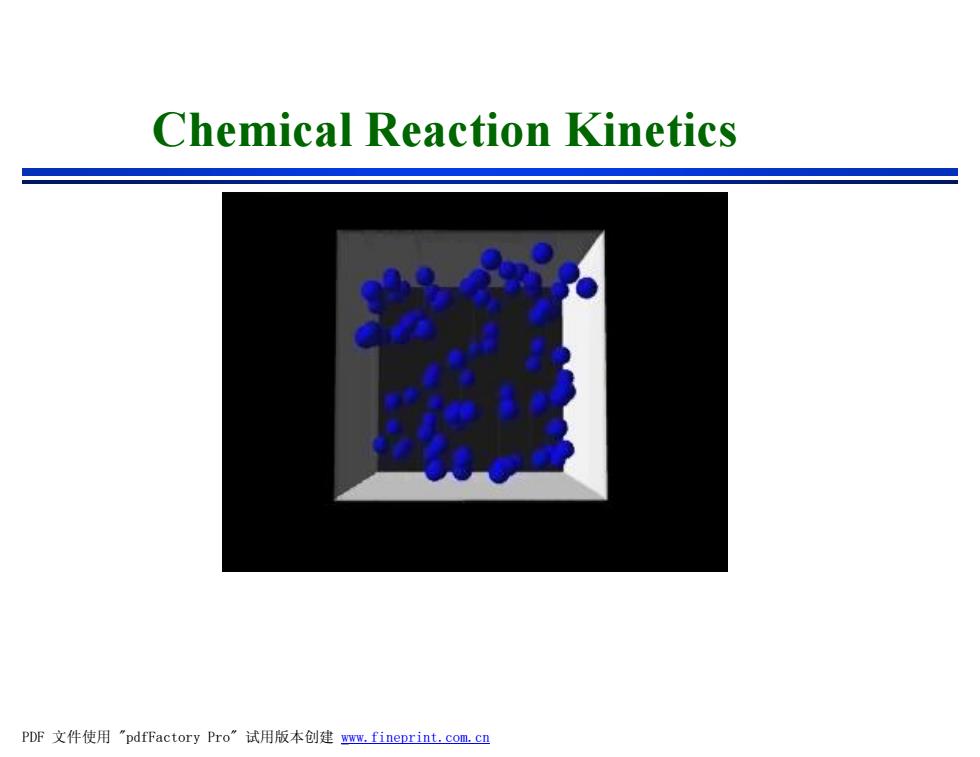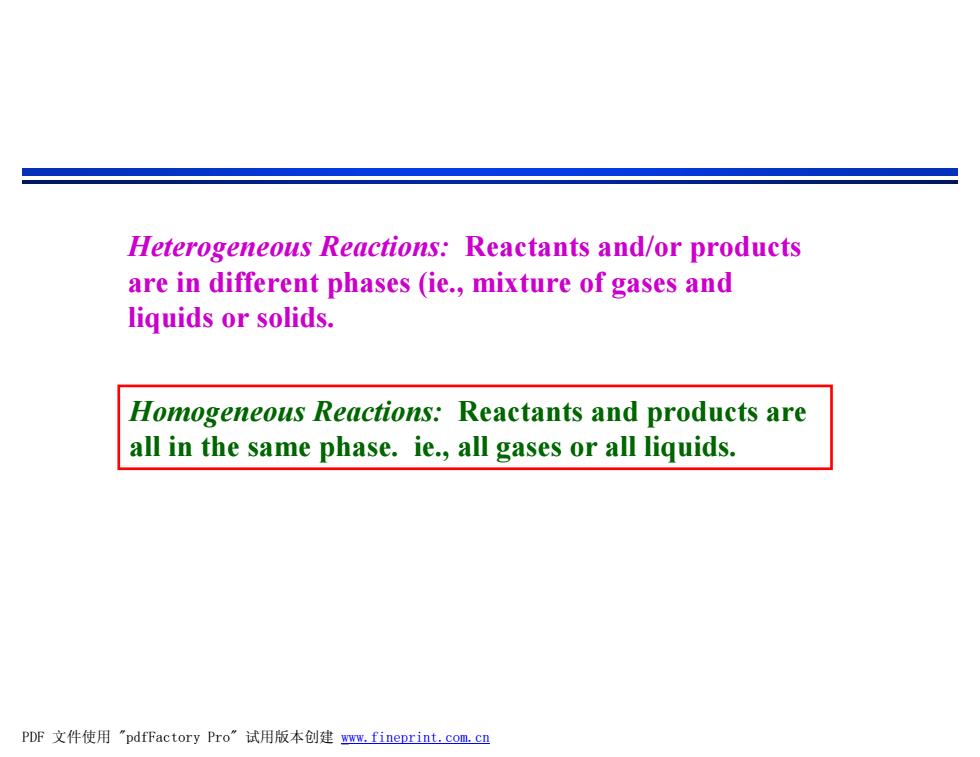
Chemical Reaction Kinetics PDF文件使用"pdfFactory Pro”试用版本创建m,fineprint.com,cn
Chemical Reaction Kinetics PDF 文件使用 "pdfFactory Pro" 试用版本创建 _www.fineprint.com.cn

Introduction This chapter introduces the principles of chemical kinetics,the study of reaction rates,by showing how the rates of reactions may be measured and interpreted. The rate of a chemical reaction might depend on variables under our control,such as the pressure,the temperature,and the presence of a catalyst,and we may be able to optimize the rate by the appropriate choice of conditions. The study of reaction rates also leads to an understanding of the mechanisms of reactions,their analysis into a sequence of elementary steps PDF文件使用"pdfFactory Pro”试用版本创建w.fineprint.com.cn
Introduction This chapter introduces the principles of chemical kinetics, the study of reaction rates, by showing how the rates of reactions may be measured and interpreted. The rate of a chemical reaction might depend on variables under our control, such as the pressure, the temperature, and the presence of a catalyst, and we may be able to optimize the rate by the appropriate choice of conditions. The study of reaction rates also leads to an understanding of the mechanisms of reactions, their analysis into a sequence of elementary steps. PDF 文件使用 "pdfFactory Pro" 试用版本创建 f www.fineprint.com.cn ÿ

Why do some reactions take place very rapidly (less than millionths of a second)while some reactions take years to occur? Why can changing the concentration(s)of reactants often change the rate with which they react? Why does temperature have such a dramatic effect on chemical reactions? Why do catalysts speed up some reactions but have little or no effect on other reactions? PDF文件使用"pdfFactory Pro”试用版本创建m,fineprint.com,cn
Why do some reactions take place very rapidly (less than millionths of a second) while some reactions take years to occur? Why does temperature have such a dramatic effect on chemical reactions? Why do catalysts speed up some reactions but have little or no effect on other reactions? Why can changing the concentration(s) of reactants often change the rate with which they react? PDF 文件使用 "pdfFactory Pro" 试用版本创建 _www.fineprint.com.cn

Heterogeneous Reactions:Reactants and/or products are in different phases (ie.,mixture of gases and liquids or solids. Homogeneous Reactions:Reactants and products are all in the same phase.ie.,all gases or all liquids. PDF文件使用"pdfFactory Pro”试用版本创建wm,fineprint.com,cn
Heterogeneous Reactions: Reactants and/or products are in different phases (ie., mixture of gases and liquids or solids. Homogeneous Reactions: Reactants and products are all in the same phase. ie., all gases or all liquids. PDF 文件使用 "pdfFactory Pro" 试用版本创建 _www.fineprint.com.cn

How fast a reaction occurs Reactions are not instantaneous-they take a finite time. Demonstration: Reaction: PDF文件使用"pdfFactory Pro”试用版本创建ww.fineprint.com,cn
How fast a reaction occurs Reactions are not instantaneous - they take a finite time. Demonstration: PDF 文件使用 "pdfFactory Pro" 试用版本创建 èwww.fineprint.com.cn

In general for the reaction: aA+bB→IL+mM Rate of reaction=dg/Vdt=dng/Vvgdt---Definition At constant volume,dng/V=dCg S0, Rate of reaction dCg/vedt Rate of reaction =-I dC=-I dCB=I dCM=I dC a dt b dt m正ldi dC dc Rate of Rate of consumption dt dt formation Vala=VB/b=Vil=VMlm PDF文件使用"pdfFactory Pro”试用版本创建m,fineprint,com,cn
In general for the reaction: aA + bB ® l L +mM Rate of reaction=dx/Vdt=dnB /VnBdt---Definition At constant volume, dnB /V=dCB So, Rate of reaction = - 1 dCA = - 1 dCB = 1 dCM = 1 dCL a dt b dt m dt l dt Rate of reaction = dCB /nBdt dt A dC A v = - dt L dC L v = VA /a=VB /b=VL /l=VM/m Rate of consumption Rate of formation PDF 文件使用 "pdfFactory Pro" 试用版本创建 f www.fineprint.com.cn ÿ

For Example 2Ht+3+H202→2H20+L3 rate -0-⅓ etc dt ● rates go as 1/(stoichiometric coefficient) Learn reactants products have opposite sign PDF文件使用"pdfFactory Pro”试用版本创建m,fineprint.com,cn
2H+ + 3I– + H2O2 ® 2H2O + I3 – etc. dt d[I ] dt d[H ] dt d[H O] dt d[I ] rate 3 1 2 2 1 2 3 1 - + - = = = - = - • rates go as 1/(stoichiometric coefficient) • reactants & products have opposite sign Learn For Example PDF 文件使用 "pdfFactory Pro" 试用版本创建 f www.fineprint.com.cn ÿ

Elementary Reactions Elementary reaction---process which occurs in a single collision or molecular event Most reactions occur in a sequence of steps called elementary reactions,each of which involves only a small number of molecules or ions. For example:H+Br2 HBr Br This equation signifies that an H atom attacks a Br2 molecule to produce an HBr molecule and a Br atom. PDF文件使用"pdfFactory Pro”试用版本创建ffm,fineprint.com,cn
Elementary Reactions Elementary reaction---process which occurs in a single collision or molecular event Most reactions occur in a sequence of steps called elementary reactions, each of which involves only a small number of molecules or ions. For example: H +Br2 HBr + Br This equation signifies that an H atom attacks a Br2 molecule to produce an HBr molecule and a Br atom. PDF 文件使用 "pdfFactory Pro" 试用版本创建 fwww.fineprint.com.cn f

Example:H2+Cl2→2HCl Four elementary reactions occurring simultaneously: Cl2→2Cl CI+H2→HCI+H H+CL2→HCI+CI 2Cl→Cl2 A H2 molecule and a Cl2 molecule never react by colliding together to form two HCI molecules! Instead: isolated Cl2 molecule falls apart to form two Cl atoms a CI atom can collide with a H2 molecule to form a HCI molecule and a H atom. PDF文件使用"pdfFactory Pro”试用版本创建m,fineprint.com,cn
Example: H2 + Cl2 ® 2HCl Four elementary reactions occurring simultaneously: Cl2 ® 2Cl Cl + H2 ® HCl + H H + Cl2 ® HCl + Cl 2Cl ® Cl2 * A H2 molecule and a Cl2 molecule never react by colliding together to form two HCl molecules! Instead: - isolated Cl2 molecule falls apart to form two Cl atoms - a Cl atom can collide with a H2 molecule to form a HCl molecule and a H atom. PDF 文件使用 "pdfFactory Pro" 试用版本创建 fwww.fineprint.com.cn f

Molecularity The molecularity of an elementary reaction is the number of molecules coming together to react in an elementary reaction. There are only three types of elementary reactions: unimolecular,e.g.Cl>2CI isolated molecule reacts bimolecular,e.g.CI+H2>HCI +H two molecules(atoms)collide and react trimolecular,three molecules (atoms)collide and react PDF文件使用"pdfFactory Pro”试用版本创建m,fineprint..com,cn
Molecularity The molecularity of an elementary reaction is the number of molecules coming together to react in an elementary reaction. There are only three types of elementary reactions: unimolecular, e.g. Cl2 ® 2Cl isolated molecule reacts bimolecular, e.g. Cl + H2 ® HCl + H two molecules (atoms) collide and react trimolecular, three molecules (atoms) collide and react PDF 文件使用 "pdfFactory Pro" 试用版本创建 fwww.fineprint.com.cn Ì